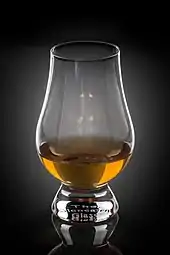Glencairn whisky glass
The Glencairn whisky glass is a style of glass developed by Glencairn Crystal Ltd, Scotland for drinking whisky. Originally designed by Raymond Davidson, managing director of the company, the shape of the glass is derived from the traditional nosing copitas used in whisky labs around Scotland.[1] The glass design was concluded with the aid of master blenders from five of the largest whisky companies in Scotland. The glass first came into production in 2001. Since that time additional mini-Glencairns and Canadian Glencairns[2] were introduced.

The original Glencairn glass is approximately 115 mm (4 1⁄2 in) in height and has been available in three variations: 24% lead crystal, lead-free crystal, and soda-lime glass. The vast majority of glasses in circulation are of the lead-free crystal variety. The soda-lime variation was discontinued in 2008.[3] Mini Glencairns look the same as regular Glencairns but are smaller and used at distilleries for serving samples. Canadian Glencairns are the largest of the three, and were made for Canadian whiskey that is usually served on the rocks (with ice), therefore the Canadian Glencairn has a wider bowl and has a 11.75 oz capacity.
The capacity of a typical Glencairn whisky glass is approximately 175 ml (6 US fl oz), and it is intended to hold approximately 50 ml (1.7 US fl oz) of liquid.
In 2006 the glass won the Queen's Award for innovation.[4][5][6]
The Glencairn glass is not the only glass on the market that is designed specifically for drinking whisky. (For example, Riedel and Norlan Glass also manufacture such glassware.) While there are numerous styles of such glasses available, the Glencairn is the first style to be endorsed by the Scotch Whisky Association, and it is used by every whisky company in Scotland and Ireland.[6]
Old Fashioned tumblers, snifters, and nosing copitas are other types of glasses that are commonly used for drinking whisky. The traditional style of whisky glass is a cut crystal Old Fashioned whisky tumbler, an iconic design that remains the most commonly used type of whisky glass. However, a tumbler does not hold and focus the aromas as much for the experience of the drinker as the other styles, which curve inwards towards the top of the glass. While not all drinkers may find the strong aroma produced by such glasses desirable, inward-curved glasses are often preferred by connoisseurs who consider the aroma especially important to the experience of a whisky.
References
- "Eden Mill Glencairn Canadian Glass". www.edenmill.com. Retrieved 2020-09-02.
- "Glencairn "Canadian" Glass". www.glencairnwhiskyglass.com. Retrieved 2020-07-05.
- "The Glencairn Whisky Glass". www.singlemaltlodge.com. Retrieved 2020-09-02.
- "The Queen's Awards for Enterprise: Innovation 2006". The Queen's Awards for Enterprise. Archived from the original on 2007-10-24. Retrieved 2 April 2020.
- "Scotland's Official Whisky Glass Celebrates Five Million Units with an Enhanced Glass and a New Livery" (Press release). China Glass Network. Drinks Media Wire. 28 August 2008. Retrieved 2 April 2020.
- "Whisky glass wins Queen's Award". BBC News. 20 April 2006. Retrieved 2 April 2020.
External links
| Wikimedia Commons has media related to Category:Whisky glasses. |
| Look up whisky glass in Wiktionary, the free dictionary. |
- Glencairn Glass U.S. Design Patent (Publication Date: June 25, 2002, Filing Date: Sept. 26, 2001, Term: 14 years from the date of issue.)